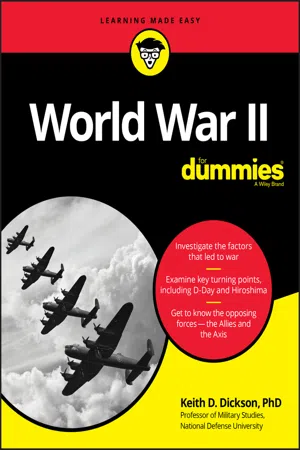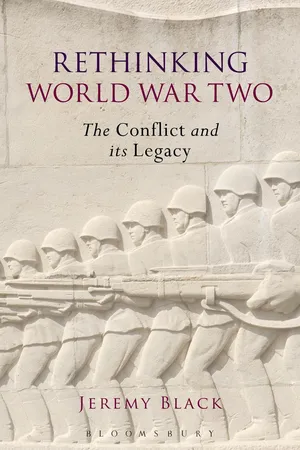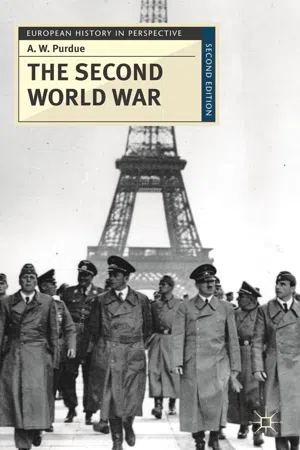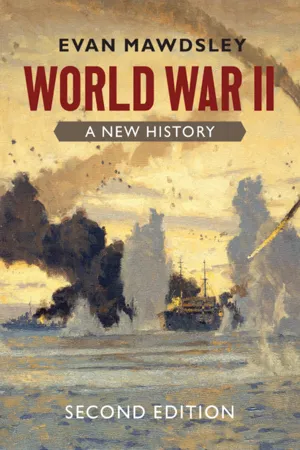History
Causes of WWII
The causes of WWII can be attributed to a combination of factors, including the Treaty of Versailles, economic instability, aggressive expansionist policies of certain countries, and the rise of totalitarian regimes. These factors led to heightened tensions, territorial disputes, and ultimately, the outbreak of a global conflict in 1939.
Written by Perlego with AI-assistance
Related key terms
1 of 5
5 Key excerpts on "Causes of WWII"
- eBook - ePub
- Keith D. Dickson(Author)
- 2020(Publication Date)
- For Dummies(Publisher)
Part 1Origins and Causes of the War, 1919–1939
IN THIS PART … Find out what the world was like during this period. Understand how the world moved into yet another world war in just twenty years. See how the aftermath of World War I led to the rise of totalitarian dictatorships bent on revenge. Get an idea of how democracies failed to provide solutions to complex social and economic problems.Passage contains an image Chapter 1
World War II: Why It Matters and What You Need to Know
IN THIS CHAPTERWhat led to the warThe major playersThe battlegroundsA very brief chronologyWorld War II is over. It’s been over since August 1945. Good guys won. Bad guys lost. What else do you need to know? First you need to know that nothing — and especially not war — is ever that simple. World War II — its causes, its battles, its tragedies, and its victories — is almost beyond comprehension.Want to see what true evil is? Study the German concentration and death camps or think about the 6 million Jewish men, women, and children who were murdered. Want a glimpse of heroism? Look at the stoicism the British displayed when London was bombed for 42 nights straight or remember the ordinary soldiers from any nation who fought against overwhelming odds toward what seemed to be inevitable defeat. Want to understand sacrifice? Consider the 25 million dead from the Soviet Union alone or the resistance fighters who gave up everything to free their countries from Nazism. Want to understand power, fanaticism, devotion to duty, political maneuvering, selflessness, selfishness, and persevering in the face of unimaginable terror? Look at events that led up to and the events that occurred during World War II. - eBook - PDF
Rethinking World War Two
The Conflict and its Legacy
- Jeremy Black(Author)
- 2015(Publication Date)
- Bloomsbury Academic(Publisher)
CHAPTER ONE Causes Debate over the causes of World War Two links contemporaries with those who come later. For contemporaries, such debate was largely political, an attempt to mobilise support, both domestic and international. For subsequent generations, in contrast, debate links the issue of war guilt for wartime opponents to more general questions of justification and vindi-cation. As a result, this chapter cannot be readily separated from those on recollection, Chapters 5 and 6. This chapter seeks to provide an account of the origins of the war down to it becoming global in December 1941. Then, Japan attacked the USA and Britain, while Germany declared war on the USA. Such an account is particularly necessary for the purposes of this book, because it demon-strates that the combatants, and their alignments, were far from inevitable and were certainly not seen in that light by contemporaries. Therefore, the discussion of how these alignments arose is a key issue in the politics involved in the war and its recollection. This discussion also relates to postwar debates over responsibility, notably because of controversies over Appeasement: the policy followed in the run-up to war towards the expansionist powers that were to comprise the Axis, Japan, Germany and Italy. Wartime alignments are also crucial to the process by which guilt or praise are apparently established by association. For example, Hungary appears ‘bad’ because it allied with Germany against the Soviet Union in 1941, whereas the Soviet Union is apparently vindicated for posterity because it was attacked by Germany that year. In practice, an understanding of the policies of these and other states requires a more subtle consideration of their situation, politics and options. For example, Eastern European powers had their own history and interests to consider. - eBook - ePub
- A. W. Purdue(Author)
- 2011(Publication Date)
- Bloomsbury Academic(Publisher)
7The view of the major cause of the war as the clash between the upholders of the existing order and those determined to overthrow it embraces ideology, in that Nazism, fascism and Marxism were all opposed for ideological reasons to the existing order, but it also takes us back to geography, history and to national nterests: a powerful German state determined to expand to greater boundaries and influence and conscious of the dangers of war on two frontiers; a greater Russia, also conscious of two frontiers with a Japanese army on one and a number of small, but hostile states on the other; a France in demographic and military decline, torn between defiance and defence; a fascist Italy with the traditional Italian ambitions in the Mediterranean, Africa and the Balkans; and a Britain, overstretched by imperial commitments, but determined, as in so much of her history, to prevent Europe being dominated by a single great power.The view of the twenties and thirties as a period dominated by competing political ideologies has some substance but cannot by itself explain the origins of the Second World War. The path to war was tortuous and involved shifting associations between disparate ideological partners, while the foreign policies of the powers were determined by national interests and ambitions as well as by ideology. The question as to which predominated, national interests or ideologies, is not susceptible to an easy answer. Hitler and Mussolini substantially devised their political philosophies which, in any case, gave pride of place to national interests. Stalin’s twisting path can be interpreted quite easily in terms of a pragmatic pursuit of Soviet interests, yet he always came up with a suitable Marxist–Leninist explanation for every change of policy, and could justify apparent inconsistencies by the claim that the interests of the Soviet state were identical with those of world socialism. - eBook - PDF
World War II
A New History
- Evan Mawdsley(Author)
- 2020(Publication Date)
- Cambridge University Press(Publisher)
Post-war Germany suffered from a requirement to pay reparations. It went through an early inflation crisis, and the prosperity of the mid-1920s was supported by American loans. World capitalism went into general crisis in the late 1920s. Economists still argue about the causes of the Depression, but it certainly had its roots in the American economy as much as the European one. The Depression is normally dated from the Wall Street Crash of October 1929. The integrated economy disintegrated. Individual states faced economic disaster, crises of their currencies, collapse of their stock markets and banking systems, and mass unemployment. They mostly attempted orthodox measures like reducing govern- ment spending or attempting to protect their own economies by putting up tariff barriers. Protectionism led to counter-measures by economic rivals, and international commerce was catastrophically reduced. A World Economic Conference which convened in London in June 1933 was unable to lift the world economy out of depression. More dangerously, nationalist leaders of some major states, including the radical right in Germany and Italy, and militarists in Japan, also looked to an alternative economic model of autarky, regional self-sufficiency. Each state would control a large regional economic zone – which the Germans called Grossraum – as part of the creation of an economic ‘new order’. Political Ideologies: (1) Liberal Democracy World War II was, of course, not just about territory and resources. It was also about politics. It was depicted by the Allies, including the Stalinist USSR, as a struggle between democracy and Fascism, a battle for ‘freedom’. In both Europe and Asia, the post-World War I international order laid out norms of political democracy. This was not the issue Europe had gone to war over in 1914. - eBook - PDF
- Michael Adas(Author)
- 2010(Publication Date)
- Temple University Press(Publisher)
T his study of the First and Second World Wars represents part of the constantly ongoing efforts of historians to understand and interpret the most destructive wars in human history. The re-examination of the origins of these conflicts and of the wars themselves stems from prior revisions of the perceptions of both and suggests that historians in the long run will need to examine and understand them as an interconnected whole, though not necessarily in terms of current conceptualizations of the world wars as an-other Thirty Years’ War. The major difficulty with the traditional dating of the two wars—the first from 1914 to 1918 and the second between 1939 and 1945—is the Euro-centric nature of this periodization. Prior to the 1990s, historians of the First World War neglected the global and imperial nature of that conflict, with its origins in the collapse of the Ottoman Empire and the consequences of that process in North Africa and in the Balkans. Their Eurocentric perspective prompted them to concentrate on Britain, France, Germany, Russia, and Austria-Hungary as the locus of the origins of the conflict, often demonizing the German Kaiser as the major precipitant of the war, as western cartoonists had done during the war. American historians tended to confine themselves to the wartime experience of the United States and its critical contribution to the Entente war effort, but without regard for or attention to the rest of the war. This Eurocentric approach extended to treatments of the course of the First World War as well. The British and Germans have received the bulk of the attention of Western historians writing in English, with the French, Rus-sian, Austro-Hungarian, Italian, and American combatants receiving a lot less CH APTER 5 The Impact of the Two World Wars in a Century of Violence _ John H. Morrow Jr. 162 • CHAPTER 5 attention beyond the works of the national historians of each power.
Index pages curate the most relevant extracts from our library of academic textbooks. They’ve been created using an in-house natural language model (NLM), each adding context and meaning to key research topics.




